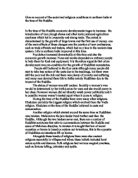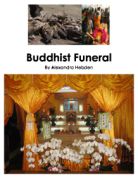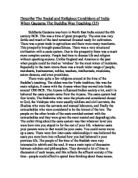Buddhists are taught to understand that everything in life happens for a purpose and all actions have consequences.
Buddhists are taught to understand that everything in life happens for a purpose and all actions have consequences. This can also be in relation to the environment and animals. Karmic consequences result in karma being collected through all actions in a Buddhists life, good or bad. Buddhists believe in reincarnation and that the karma you collect in this life will play a major role in the outcome of your next. If a Buddhist harmed the environment or animals they would collect bad karma resulting in a life of ignorance, suffering and possibly a lower rebirth. Reincarnation demonstrates we have all been animals in our past lives from being reborn time and time again. Potentially we could have been related to all beings, animal or human. These beliefs would have a definite influence on how Buddhists treat animals. Animals around them could be creatures they have loved and cared for and by harming them or treating them unjustly, Buddhists may be being disrespectful to beings they once cherished. Reincarnation also alters Buddhist views on the environment. They believe we depend on the world for survival, not and in the future. If they destroy, damage and harm the environment now they will only have to suffer a bad life next time round as consequence of their own actions. Engaged Buddhism is when the teachings of Buddhism are applied to the lives of Buddhists. This relates to
Describe Buddhist teaching about how people should treat the environment and animals.
Jenna Wake Buddhism coursework a) Describe Buddhist teaching about how people should treat the environment and animals. Buddhists believe we should live in harmony with each other and nature. Buddhists try to educate people to respect the environment, this includes yourself, other people and nature. Buddhists believe people should show Metta, loving kindness to all things. Doing this promotes a person good karma, this results in Punna, skilful acts, which in turn earns Merit. Merit helps people gain enlightenment. Buddhists believe that Metta reflects collective karma. This is the idea that everything, everybody does are reflected onto everything and everybody, around them. So good karma makes the environment a better place and bad karma can cause bad changes to the environment. A Buddhists tries, through their karma to get rid of greed, hatred and ignorance, this also applies to institutions that run our societies and multinational corporations that work in our societies. Through institutions and multinational companies, the three poisons of greed, hatred and ignorance are spread across the world. Tich Nhat Hahn, a Buddhist from Vietnam, speaks of engaged Buddhism. This is the belief that Buddhism is concerned about the way people live and is engaged in trying to improve life for them. An example of engaged Buddhism in Britain is the group called "Network of engaged
Describe a journey to a Buddhist place of Pilgrimage.
Becki Miller Pilgrimage Describe a journey to a Buddhist place of Pilgrimage Pilgrimage is a special journey to an important place and in a Buddhists case usually a place of worship. It often a once in a lifetime trip for the purpose of aiding the journey to enlightenment. For a Buddhist there are four main places that they might go on a pilgrimage, the Lumbini grove, Bodh Gaya, the deer park at Sarnath and Kushinara. The Lumbini Grove is an obvious place to go on Pilgrimage as it is the birthplace of the Siddartha Gotama. This is marked by an inscription on a pillar which reads "Here the Buddha was born". The journey to the Lumbini grove is half an hour from the nearest train station, followed by hours on cycle, rickshaw or on foot. There are a few monks, two temples and a pool at this remote site. Bodh Gaya is the place of Siddartha Gotama's enlightenment, it is the most sacred place of pilgrimage in the Buddhist world. Clearly many Buddhists believe that this is a place of great "spiritual power" which becomes more intense each time pilgrims visit, as this is the place where Siddartha became Buddha. Many people believe that this is the site of enlightenment for all great Buddhists; however, in my opinion this is incorrect as there are hundreds of great Buddhists in the world, in fact I feel that any Buddhist that has pure faith is great Buddhist, and surely not
Buddhists are interested in the truth about the way things are. The law of life is what the Buddha discovered at his enlightenment and what he then taught to others.
Reflection on Buddhism HRT3M1 Larissa Balicki Mr. Nadon Oct. 23'03 "See everything around you as nirvana. See all beings as the Buddha. Hear all sounds as mantras." Buddhists are interested in the truth about the way things are. The law of life is what the Buddha discovered at his enlightenment and what he then taught to others. The Buddha taught that suffering is overcome by following a path to 'Nirvana', the unchanging state that is reached by all enlightened beings. They believe that it represents the true nature of reality. Nirvana is the ultimate state of pure being, so for Buddhists there is no belief in or worship of a personal creator God. To reach Nirvana involves the development of morality, meditation and wisdom. If you see everything as Nirvana, you would have achieved the very essence of Buddhism, finding wisdom and joy in everything and dismissing negativity and suffering in your life. 'Buddha' means Enlightened One. To see all beings as Buddhas would mean that everyone would understand the truth about the way things are. Buddhists do not claim that one path is right or wrong, or use "I" or "person" to mean a permanent personality. They consider a person to be "a flow of being," subject to constant physical and psychological change, which continues through life beyond death. Buddhists believe that a person is in reality a chain of life, a
give account of the social and religious conditions in northern India at the time of the Buddha.
Give an account of the social and religious conditions in northern India at the time of the Buddha. In the time of the Buddha economic developments began to increase . the introduction of iron plough shares and other tools produced agriculture surpluses which led to prosperity and strong trade. The period is characterised by the growth of large towns and the first use of money. one of the main effects of these changes was the creation of new professions, such as trade officials and traders, which had no place in the ancient class system. Life in northern India improved at this time. Population increased dramatically at this time and also the economic growth increase. Nuns and monks depended on ordinary people to help them for food and equipment. It is therefore arguable that urban development was pre-condition for the growth of Buddhist monasteries. People still believed in the four casts although many people did start to take less notice of the casts due to his teachings, but there were still the poor and the rich and there was plenty of poverty and suffering and many men devoted there life to faiths mainly Buddhism due to the impact of the Buddha. The status of women was still unclear. Socially a women's was would be determined by her birth just as for men and she would marry in her class. However women did not directly wield power politically and it is possible women
Explain what followers of another religion believe about the reasons why there is suffering in the world
Explain what followers of another religion believe about the reasons why there is suffering in the world The question of suffering -mentally and physically- is fundamental to the Buddhist faith. Many of its teachings are centred around it. The four noble truths are the key most important Buddhist teaching . All life is suffering (Known as dukkha) 2. Dukkha arises because of our desires and craving. 3. Dukkha can cease to exist if we put an end to our craving 4. The way to overcome dukkha is to follow the eightfold path, (Action, Livelihood, Effort, Mindfulness, Concentration, Understanding, Thought and Speech). Prince Siddhartha Gotama (who later became the Buddha) first encountered suffering when he left the palace for the first time. He was met by the four sights: old age, sickness, death and a Holy man. Whilst being in the palace he had been protected from all the different types of suffering and when he came across these affected by so much suffering he decided to leave the comfort of the palace and all of his glorious possessions and seek out the meaning of life and the truth behind life. Buddha believed there are three features all things in life share; firstly, nothing ever lasts, nothing stays unaffected all life is impermanent and ever changing this is called Anicca. Secondly, all life forms are affected by suffering Dukkha, and thirdly nothing has a soul
Buddhist funerals
Buddhist Funeral By Alexandra Hebden AO1- Describe a Buddhist funeral and ways in which the mourning period might be observed. Funerals vary from culture to culture; some are simple and quite, whilst others are loud including party's, celebrating life and death. However for Buddhist a funeral is usually a simple and private affair. There are many different types of Buddhist communities, and each one holds a different type of funeral, from a cremation, to a 'sky burial'. Some of the main Buddhist communities are the Theravada Buddhists, the Tibetan Buddhists and the Mahayana Buddhists, each of them holding a different style of ceremony. The Theravada Buddhists who mainly live in Thailand, encourage a dying person to read or chant passages from the Suttas, they do this to try and improve their Karma as they are very close to the time of their re-birth. After the death, the relatives, pour water over a hand of their dead family member, the body is then placed in a coffin. However he or she is not then just shut away in the dark, the body is surrounded by lights and incense, and sometimes passages from the Abhidhamma will be read over the body, by Bhikkus's. Traditionally the bodies are cremated, as was the Buddha. In Theravada Buddhist communities the cremation usually takes place about three days after the death, until his point the body lays in the home, visited
Buddhist Worship - Temples and Symbols
Buddhist Temples Buddhist Temples are found all over the world. They are built in large numbers in China, Japan and all over Asia. They comprise monks and nuns who live a rather extreme lifestyle. They live on donations by the people living near the temple. A conventional temple will have a set of buildings. Each building has its own purpose. These are: Buddhist Temples Symbolise 5 things: . Fire 2. Water 3. Earth-symbolised by the square base. 4. Water 5. Wisdom Sadafha Gatarma: Sadafah Gatarma is often referred to as Buddha. He was the founder of Buddhism. Sadafah was a prince in Lumbini(Nepal). He was the prince of the Shakya Clans village of Kapilavatthu/kapilvastu (in the foothills of the Himalayas). Sadafah married at the age of 29 and had a wife and a child. However when he discovered the difference between a life of aristocratic luxury and life of suffering he left his family, wealth, power and inheritance. After six years, around 528 BC, he believed the practices did not lead to greater understanding into the purpose of life. He abandoned them and concentrated on meditation. This enlightenment is called a state of "Bodhi," this lead to the name: "Buddha," or "enlightened one." The Buddha emphasized that he was not a moral god or any supernatural force and that there are no messengers of a god-prophets-and that enlightenment . For the remaining 45
Describe The Social and Religious Conditions of India When Gautama The Buddha Was Teaching.
Describe The Social and Religious Conditions of India When Gautama The Buddha Was Teaching (33) Siddharta Gautama was born in North East India around the 6th century BCE. This was a time of great prosperity. The area was very fertile and much of the land remained forested ready for cultivation. There was a great trade in agriculture and there were many merchants. This prosperity brought peacefulness. There was a very structured civilisation with a caste system. Due to the prosperity there was a much more complex society. People had time to discuss life and religion without upsetting anyone. Unlike England and America in the past when people could be tried as 'witches' for the most minor of incidents. Especially in the main towns there was a much wider range of people; merchants, businessmen, nobles, teachers, intellectuals, musicians, actors dancers, and even prostitutes. There were quite a few religions around at the time of the Buddha's teaching. The oldest was the Vedic tradition; this was the main religion, It came with the Aryans when they moved into India around 1500 BCE. The Aryans influenced Indian society a lot, and it is believed the caste system came from the Aryans. The caste system had four levels; The Brahmins who were the priests and considered closest to God, the Vaishyas who were usually soldiers and civil servants, the Shudras who were the servants and
Puja: Buddhism
R.s homework- Puja . Describe a typical Buddhist Temple. Modern temples are usually very bright and colourful, with three main features. There will be a shrine room with a main Buddha image and many other images, either statues or wall paintings telling the story of the Buddha's life. There are also gigantic statues of the Buddha to make him look massive. Horns may be blown; there may be the chanting of mantras over and over again. The robes are richly coloured. There may be candles, both in front of the images and around the shrine room. There may also be incense burning. Tibetan Buddhists use prayer wheels. Mantras are written out on paper and tucked into prayer wheels. Small prayer wheels are carried in the hand. Larger ones are fixed and people turn them with their hand as they pass, reciting a mantra. A temple is made up of a few different buildings. Firstly there is the temple itself. This is a very ornate building where the Buddhists will meditate, pray and worship. Secondly is the building that the monks live in. The walls of the temple will be elaborately decorated with images from the Buddha's life and in some temples the walls will also picture events from recent times. In the temple that I visited in Birmingham, the walls had images of nuclear war heads, old prime ministers and technology. The ceiling of the temple pictured the Buddha in the different











